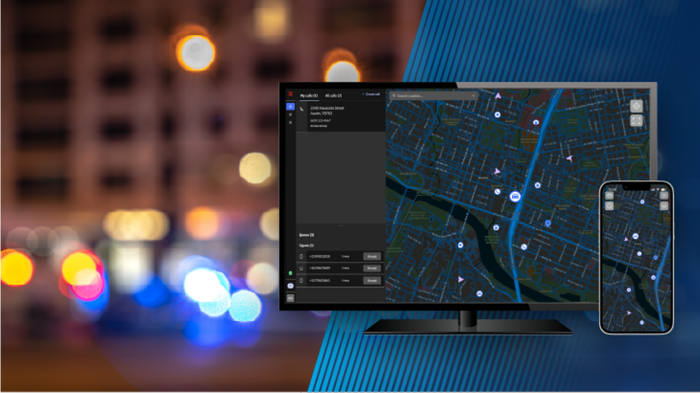Data above voice systemsData above voice systems
In the last 20 years, long-haul transmission networks were upgraded to transport digital signals due to the huge growth of the information technology
January 1, 2004
In the last 20 years, long-haul transmission networks were upgraded to transport digital signals due to the huge growth of the information technology market (metropolitan-area networks, interconnection of local-area networks, the Internet, digital cellular networks like GSM or CDMA, digital trunking networks like iDEN, etc).
Originally, the long-haul transmission network was designed to transport analog signals using mainly high-capacity long-distance FDM-FM analog microwave radios (Frequency Division Multiplexing/Frequency Modulation). This equipment is suited to transport voice signals from analog telephone multiplexers (it cannot transport digital signals directly). Digital microwave radios are adequate to transport digital signals, however, analog microwave radios are still necessary worldwide to transport analog television signals (NTSC or PAL), the leftover FDM-FM telephone signals and, mostly, to preserve the enormous investments made in the past.
Introduction to DAV
Hybrid data systems were developed as a cost-effective solution to transport digital signals over existing terrestrial analog microwave radio networks. In these systems, a FDM-FM telephone or television base band is transmitted with a digital base band in the same radiofrequency channel and the final result is a composite signal.
Conceptually, there are three distinct hybrid systems in terms of the occupied bandwidth:
Data Under Voice — DUV
DUV inserts a digital base band under the FDM-FM telephone base band. An example of a commercial DUV system in the United States was AT&T’s digital data service (DUV signal + L1800 FDM signal). Figure 1 shows the combined frequency spectrum of the DUV + FDM-FM hybrid data signal.
Data In Voice — DIV
DIV inserts a digital base band in the middle of the FDM-FM telephone base band by using a steep band-pass filtering process. DIV systems presuppose the use of efficient bandwidth management schemes to transmit data streams in small band-widths (i.e., a high bandwidth efficiency). A commercial DIV system was developed by Fujitsu of Japan. Figure 2 shows the combined frequency spectrum of the DIV + FDM-FM hybrid data signal.
Data Above Voice — DAV
DAV inserts a digital base band above the FDM-FM telephone base band. Figure 3 shows the combined frequency spectrum of the DAV + FDM-FM hybrid data signal.
We can define DAV as a hybrid transmission system which carries a digital data signal that occupies a portion of a microwave radio frequency spectrum above the frequencies used only for voice transmission (FDM-FM signal). DAV is transmission equipment that is used in the transition era between the analog-only telecommunications world and the digital-only telecommunications world. The importance of this type of equipment is reduced as pure digital transmission systems are deployed all over the world.
Figures 1, 2, 3, and 4 are not in scale (neither the power level on the Y-axis nor the frequency on the X-axis).
A possible fourth system — Data Above Video — is a variation of DAV. In DAVID (or DAV TV) hybrid systems the FDM-FM telephone base band is substituted by an Amplitude Modulation/Vestigial Side Band (AM-VSB) analog television signal.
Conceptually, DAVID hybrid signal spectrum is similar to the DAV spectrum. Figure 4 shows a DAVID signal plus an AM-VSB television signal. In this article, the word DAV is always used both for the real FDM-FM DAV and DAVID.
General philosophy of DAV
In a general terrestrial analog microwave radio system, the position of DAV on the transmitter side is shown on Figure 5 (i.e., DAV TX or combiner DAV) and the position of DAV on the receiver side is shown on Figure 6 (i.e., DAV RX or splitter DAV).
In the first case, DAV performs the function of combining a data stream with a telephone or television base band. In the second case, DAV performs the function of splitting the combined or hybrid signal into its original components (i.e., telephone or television plus data). Data stream is an E1 aggregate (in CEPT hierarchy) under the recommendation ITU-T G.703 or a T1 aggregate (in ANSI hierarchy) in the United States. Although, in the present time, an E1 (or T1) circuit is considered a low-capacity data circuit it is still very useful to provide digital communications to villages in the country.
DAV is always inserted before the radio switching subsystem on the transmitter side and after the radio switching subsystem on the receiver side. This rule determines that the hybrid signal will be switched when radio switching occurs. DAVID is always inserted on the transmitter side after the Sound-and-Video Combiner. On the receiver side, DAVID is always inserted before the Sound-and-Video Separator.
If DAV equipment becomes inactive it is necessary to guarantee the analog FDM-FM base band traffic continuity. This is accomplished by a manual by-pass made independently for transmitter and receiver sides. This by-pass occurs in the Intermediate Distribution Frame.
If a power failure occurs in the power subsystem of the DAV equipment the by-pass prevents the loss of the FDM-FM telephone base band.
Figure 7 shows the fundamental building blocks for DAVs.
On the transmitter side, the incoming data signal passes first through a 4-Phase Phase-Shift Keying modulator (4-PSK). By means of a combiner filter the output hybrid signal is created (the combiner filter is a low-pass filter for the analog signal and a band-pass filter for the digital signal).
On the receiver side, the combined signal is divided by the splitting filter where the digital portion is recovered by the 4-PSK demodulator.
The signal at the output of the 4-PSK modulator (= MOD 4-PSK TX) and the signal at the input of the 4-PSK demodulator (= DEM 4-PSK RX) is called data subcarrier.
Table 1 shows information on power levels, base band, pilot tones and data subcarrier in analog radio systems containing 960, 1,800, and 2,700 telephone channels as well as television. DAV equipment can also be installed on a 1,260-channel microwave analog radio system.
Data subcarrier causes interference onto the FDM-FM signal (the analog baseband). In a similar way, the FDM-FM signal causes interference onto the data subcarrier. It is a mutual interference condition and to reduce this harmful interference there are some precautions to take:
A scrambler circuit must be used in the transmitter stage to reduce the peak in the data subcarrier frequency spectrum;
The conscious choice of the power levels in the following interfaces: SC In, SC Out, BB In, and BB Out;
Limiting the bandwidth occupied by the data subcarrier by means of a raised cosine roll-off filter;
TX combiner and RX splitter frequency response curves.
Figure 8 illustrates, conceptually, the mutual interference condition between the FDM-FM signal and the data subcarrier.
There are three different types of DAVs (according to the Data Subcarrier Frequencies — DSC):
DAV Type I
Freq DSC = 16.0 MHz = 2,700 channelsDAV Type II
Freq DSC = 10.3 MHz = 1,800 channels plus 1 TV channelDAV Type III
Freq DSC = 7.5 MHz = 960 channels
Hybrid frequency spectrum
In figure 3 we shown a generic hybrid spectrum (FDM-FM + DAV). In most cases DAV is installed in microwave radiolinks carrying 1,800 telephone channels. Therefore, it is interesting to analyze this composite signal (= FDM-FM 1,800-channel + DAV) more deeply.
From table 1 we know that the frequency of the radio continuity pilot tone is 9,023 kHz for systems carrying 1,800 telephone channels. The analog FDM-FM baseband is from 300 to 8,248 kHz. Finally, the data subcarrier frequency is centered at 10.3 MHz. Having these values in mind, it is possible to sketch the frequency spectrum of the FDM-FM 1,800-channel + DAV composite signal (Figure 9).
Internal functions
DAV equipment performs a lot of functions and its actual block diagram is considerably more complex than that of Figure 7. In general, digital transmission systems include a series of standard building blocks independently of the modulation scheme and capacity in use.
Main functions performed at the transmitter side are:
Amplitude Equalization
Compensates amplitude distortions due to the coaxial cables transporting digital signals.
Clock Recovery
Extracts or recovers the clock embedded in the line code (the clock is not directly transmitted).
Bipolar (Line Code) to NRZ Unipolar Conversion
Non-Return-to-Zero coding is used inside the digital equipment and the converter converts the bipolar line code (used to transmit signals on cables) to NRZ unipolar code (NRZ is adequate to be used in electronic circuitry).
Multiplexing (frame creation)
Creates the frame by inserting the service bits (i.e., parity bits and synch bits). This block exists only in digital equipment that creates frames.
Scrambling
The randomic stream is transformed into a stream having a mark rate equal to ½. This action guarantees the clock recovery and generates a more homogeneous frequency spectrum. The mark rate is the ratio of the number of marks and the total number of bits in a given time unit (mark is another name given for a HIGH logical level).
Stream Conversion or Series-Parallel Conversion
The input stream is transformed in a convenient number of streams for the modulation stage. For a 2-PSK modulation scheme we have one stream; for a 4-PSK modulation scheme we have two streams; for an 8-PSK modulation scheme we have three streams and, finally, for a 16-QAM modulation scheme we have 4 streams. That is to say:
Differential Coding
It is used to eliminate the signal phase ambiguity.
Digital-to-Analog Conversion
Symbol bits are transformed into discrete voltage levels.
Nyquist Filter Pulse Formatting
The signal is bandlimited to eliminate inter-symbol interference. This is done by passing the pulses through Nyquist low-pass filters. In the transmitter side we have the squared filtering transfer function and in the receiver side we have the other squared filtering transfer function, that is to say:
where:
Ω is the angular frequency (in radians per second) and f is the linear frequency (in hertz).
Modulation
In-phase and quadrature branches are amplitude modulated and then summed to generate the equipment intermediate frequency. 4-PSK modulation scheme is used in DAV systems.
Combining Filtering (Low-Pass / Band-Pass) and Analog Baseband Power Level Adjustment
Analog FDM-FM and data spectrums are combined by means of two filters (low-pass for the FDM-FM signal and band-pass for the data subcarrier signal). The combiner filter unit also adjusts baseband power level to compensate for the filter insertion loss. The insertion loss is the internal loss of the filter (due to the Joule effect) plus the mismatching loss in the two interfaces (input and output). In a perfect-matching condition both MLINPUT and MLOUTPUT are equal to zero.
where:
FIL = Filter Insertion Loss ( dB )
MLINPUT = Input Mismatching Loss ( dB )
MLOUTPUT = Output Mismatching Loss ( dB )
FLJOULE = Filter Internal Loss due to the Joule Effect ( dB )
In the receiver section we have the following blocks:
Splitting Filtering and Baseband Power Level Adjustment
Demodulation
Clock / Carrier Recovery
Receive Pulse Formatting (Nyquist Filter)
Analog-to-Digital Conversion
Differential Decoding of the Streams
Stream Conversion (Parallel-Series Conversion)
Descrambling
Frame Alignment/Demultiplexing
Unipolar (Equipment Code) to Bipolar (Line Code) Conversion
DAV equipments also have an alarm unit (for TX and RX) and a Bit Error Ratio Unit (the BER evaluation is based on the parity bit value).
Field deployment
DAV equipment can be installed in several types of microwave radio-relay stations, that is to say:
Terminal Stations
With FDM-FM Telephone Multiplex Equipment
Figure 10 shows a terminal station equipped with telephone multiplex and data multiplex. COM / MOD symbolizes analog radio equipment switching / modulation functions.
With Television Center Equipment ( TCE )
Figure 11 shows a terminal station equipped with data multiplex and TCE. At the output of the TCE, we have sound and video signals. Analog input of the DAV is connected to the Audio-Video Combiner / Splitter (AVCS) equipment.
With Line Terminal ( LT )
Figure 12 shows a terminal station equipped with two types of LTs: Data LT and analog LT (also known as pure LT).
Repeater Stations
With Multiplex and System Change
In this case we have a telephone multiplex and two systems (A and B).
With Multiplex and Without System Change
Figure 13 shows a repeater station equipped with telephone multiplex and no system change. The digital signal is out-putted from a DAV and enters the other one directly (without passing the telephone multiplex). Letter A designates the system (the same in both sides).
Without Multiplex and With System Change
In this case there is not a telephone multiplex, however, there are two systems (A and B).
Without Multiplex and Without System Change
Figure 14 shows a repeater station without telephone multiplex and without system change. There is an attenuator (symbolized by ATTEN) installed in the analog part of the DAVs to compatibilize the power levels.
Testing DAV
The complete field acceptance procedure of DAV equipments (already installed in analog microwave routes) needs several tests and instruments, listed as follows.
Visual Inspection
Number of Units and Composition (type of DAV)
Painting and General Visual Appearance
Labelling of the Units
Alarms
Maintenance:
Ohmmeter
OBS.: MAINT yellow LED must be ON.
Synch Loss:
Ohmmeter
E1 (or T1) Data Generator
Absence of Data Subcarrier in the Combiner:
Ohmmeter
Absence of Data Subcarrier in the Splitter:
Ohmmeter
Absence of Data in the Combiner Input:
Ohmmeter
E1 (or T1) Test Set
Absence of Data in the Splitter Output:
Ohmmeter
E1 (or T1) Test Set
Bit Error Ratio:
Ohmmeter
E1 (or T1) Data Generator
Radiofrequency Variable Attenuator
Load
BER Tester
E1 (or T1) Interface Waveform (according to an ITU-T or ANSI specific mask)
E1 (or T1) Data Generator
Oscilloscope
OBS.: 2,048 kbit/s for an E1 data stream or 1,544 kbit/s for a T1 data stream.
Input Jitter
Level Generator
Jitter Generator / Meter
BER Tester
Figure 15 shows the Maximum Allowed Input Jitter Mask to be used in the Input Jitter Test, according to the CCITT G 823 standard.
Jitter Gain (Jitter Transfer Function)
Level Generator
Jitter Generator / Meter
Figure 16 shows the Jitter Transfer Function Mask to be used in the Jitter Gain Test, according to the CCITT G 823 standard.
BER versus Signal-to-Noise Ratio
Noise Generator
E1 (or T1) Data Generator
Load
Radiofrequency Variable Attenuator
Noise Meter
BER Meter
Amplitude Response versus Baseband Frequency (75 ohms unbalanced)
Level Generator
Selective Level Meter
OBS.: This test is also known as “Baseband Frequency Response”.
White Noise Loading (Telephone Systems)
Noise Generator / Meter
Telephone Baseband Selective Noise (75 ohms unbalanced)
Selective Level Meter
Load
Combined Signal Output Level (Data and Analog Baseband)
Level Generator
Wideband Level Meter
Data Subcarrier Frequency Accuracy
Frequency Counter or Frequency Meter
Data Subcarrier Output Level from Combiner (75 ohms unbalanced)
Wideband Level Meter
Baseband Signal Output Level (75 ohms unbalanced)
Level Generator
Selective Level Meter
Splitter Filter Attenuation / Combiner Filter Attenuation (75 ohms unbalanced)
Level Generator
Selective Level Meter
Return Loss (or VSWR) at Input / Output Baseband, Data, and DSC Interfaces
Network Analyzer
Return Loss Bridge
20 dB Standard Load
Level Jump / Phase Jump
E1 (or T1) Data Generator
BER Tester
Noise Generator
Wideband Level Meter
Level Jump Generator / Phase Jump Generator
Hybrid Bridge
Square Wave Generator
Variable Attenuator
Cables
OBS.: It is necessary to check for bit errors in the receiver side due to the sudden attenuation (or phase) increase in the data path.
Periodic & Random Signal-to-Noise Ratio (both for Television)
Level Generator
Wideband Level Meter
Load
Television Weighing Circuit (Weighing Filter)
Low-Pass Filter (4 MHz)
Low-Pass Filter (1 kHz)
High-Pass Filter (10 kHz)
Oscilloscope
Some previous items are not applicable to all DAV equipments available in the market (there are several differences among manufacturers).
System quality equation
In microwave radio systems equipped with DAVs the generic equation for quality is given by:
where:
CNR = Carrier-to-Noise Ratio (also known as C/N);
SNR = Signal-to-Noise Ratio (also known as S/N);
Fdsc = Data Subcarrier Frequency (MHz);
Fmea = Measurement Frequency (MHz);
Bdat = Data Signal Bandwidth (kHz);
Bvoice = Voice Channel Bandwidth (kHz);
Emph = Emphasis Improvement between Fmed and Fdsc (dB);
Lev = Data Subcarrier Relative Power Level at the Output (dB);
Log = Decimal Logarithm.
CNR is calculated for a 10E-6 BER and its value is obtained from a theoretical curve BER × CNR plus a practical additional degradation value (due to several imperfections). The obtained value depends on the modulation scheme and equipment manufacturer.
Bvoice is the effective voice band for a standard multiplex channel (from 0 to 4,000 Hz). For this type of multiplex channel Bvoice is equal to 3,100 Hz (from 300 to 3,400 Hz).
So, calculating the SNR for a DAV system with 1,800 telephone channels, for a 10E-6 BER, we have:
CNR = 16.5 decibels
Fdsc = 10.3 MHz ( table 1 )
Fmea = 7.6 MHz
Considering service bits we have the following bit rate:
The fraction 63/62 comes from the DAV’s frame format (this fraction will vary according to the way the frame is created by each equipment).
Therefore, the symbol rate (expressed in megabauds) is given by:
Bdat (expressed in MHz) is numerically equal to the symbol rate, that is to say:
Bvoice = 3,100 Hz
Emph = 2.4 decibels ( value obtained from the emphasis curve )
Lev = 10 decibels
Substituting the previous numerical values we have:
SNR = 32 decibels
This is the minimum acceptable value for the systems with 1,800 telephone channels with a 10E-6 BER. In practice, it is adopted a minimum value greater than the previous one (i.e., the limiting value of 40 decibels). SNR is measured in the test item named BER versus SNR. Figure 17 shows a plotting of BER × SNR with the theoretical SNR of 32 and the limiting SNR of 40 (note the prohibited area).
Marcello Praca Gomes Da Silva is Senior Telecommunications Engineer Transmission Coordinator with Nextel Telecomunicaçōes inRio de Janeiro, Brazil.



